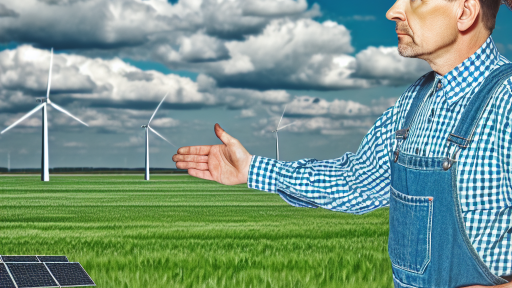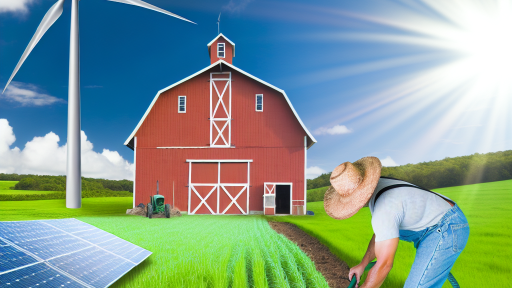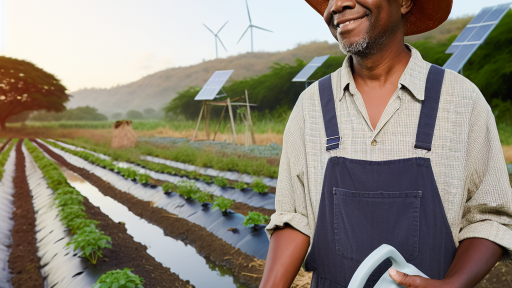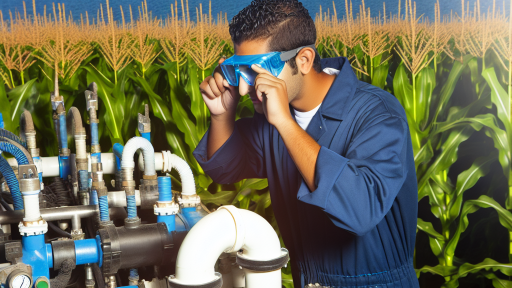Introduction to Solar-Powered Irrigation Systems
Solar-powered irrigation systems offer a sustainable solution for modern agriculture.
They play a vital role in enhancing water efficiency in farming.
These systems harness solar energy to power irrigation pumps.
As a result, they reduce dependency on traditional energy sources.
Adopting solar technology enhances resilience in water-scarce regions.
Farmers can significantly decrease their operational costs through these systems.
In addition, they contribute to environmental sustainability.
Improved water management leads to healthier crops and increased yield.
Importance of Water Efficiency
Water scarcity is a pressing global issue affecting agriculture worldwide.
Efficient water use conserves resources for future generations.
Solar-powered systems mitigate the risks associated with water shortages.
Farmers can achieve more with less water while maintaining productivity.
Moreover, this efficiency lowers water treatment and transportation costs.
Benefits of Solar-Powered Irrigation
These systems provide several advantages over conventional irrigation technologies.
- They reduce greenhouse gas emissions by minimizing fossil fuel usage.
- Solar-powered systems enable farmers to irrigate remote areas effectively.
- They increase access to clean water for agricultural use.
- Additionally, they facilitate timely irrigation, optimizing crop growth cycles.
Embracing solar technology not only boosts farm resilience but also promotes ecological balance.
Transform Your Agribusiness
Unlock your farm's potential with expert advice tailored to your needs. Get actionable steps that drive real results.
Get StartedBenefits of Solar-Powered Irrigation
Efficiency in Water Use
Solar-powered irrigation systems optimize water usage on farms.
They utilize renewable energy to power irrigation pumps.
This reduces reliance on grid electricity and fossil fuels.
Consequently, farmers notice significant reductions in energy costs.
Efficient systems can adapt to different crop needs.
This flexibility ensures that plants receive the right amount of water.
Moreover, these systems operate independently, reducing downtime.
As a result, crop yields often improve with enhanced watering practices.
Sustainability and Environmental Impact
Solar irrigation systems promote sustainable farming practices.
They decrease carbon footprints by using clean energy.
This shift helps combat climate change effectively.
By conserving water, these systems protect local aquifers.
Farmers can contribute to ecosystem health by adopting these methods.
Furthermore, solar-powered systems can integrate with other sustainable technologies.
For example, coupling with rainwater harvesting improves resource efficiency.
Eventually, this approach leads to healthier agricultural landscapes.
Economic Benefits
Implementing solar-powered irrigation can lead to cost savings.
Initial investments often pay off within a few years.
Farmers can benefit from reduced operational costs and energy bills.
In addition, improved crop yields translate to higher profits.
Grants and subsidies may also support the transition to solar systems.
As technology advances, costs continue to decrease.
This accessibility encourages wider adoption among smallholder farmers.
How Solar-Powered Irrigation Systems Work
Overview of Components
Solar-powered irrigation systems consist of several key components.
Showcase Your Farming Business
Publish your professional farming services profile on our blog for a one-time fee of $200 and reach a dedicated audience of farmers and agribusiness owners.
Publish Your ProfileThe primary elements include solar panels, pumps, and control systems.
Solar panels capture sunlight and convert it into electrical energy.
Pumps transport water from sources like wells or rivers.
Control systems manage energy use and water flow effectively.
Solar Panels
Solar panels are crucial for harnessing renewable energy.
They are typically mounted on rooftops or ground-mounted structures.
These panels generate electricity during daylight hours.
Advanced panels maximize energy efficiency and output.
Pumps and Water Distribution
Pumps are powered directly by solar energy.
They come in various types, including submersible and surface pumps.
Submersible pumps are ideal for deep wells.
Surface pumps work well for shallow water bodies.
These pumps move water to irrigation systems using minimal energy.
Control Systems
Control systems optimize the operation of solar-powered irrigation.
They include timers and sensors to monitor soil moisture levels.
This data allows for efficient water usage and scheduling.
Moreover, remote monitoring options can enhance control.
Energy Storage
Energy storage systems ensure continuous operation.
Batteries store excess energy generated during sunny days.
This stored energy powers the system when sunlight is unavailable.
Therefore, irrigation can occur even in the evening or cloudy days.
Environmental Benefits
These systems promote sustainable agriculture practices.
Using solar energy reduces dependence on fossil fuels.
Additionally, they lower greenhouse gas emissions significantly.
This approach conserves water and increases crop yields.
Find Out More: Transitioning to Renewable Energy in Agriculture
Comparison of Solar-Powered vs. Traditional Irrigation Systems
Energy Sources
Solar-powered irrigation systems utilize sunlight as their energy source.
Conversely, traditional systems often rely on electricity or fossil fuels.
This difference in energy source affects operating costs significantly.
Moreover, solar energy is renewable and sustainable.
In contrast, fossil fuels are finite and contribute to environmental degradation.
Installation and Maintenance
Installing solar-powered systems generally requires less infrastructure.
They often involve simpler installation processes than traditional systems.
Additionally, solar irrigation systems demand less maintenance overall.
Traditional systems may need regular maintenance on pumps and electrical systems.
Ultimately, this leads to reduced downtime for solar-powered systems.
Water Efficiency
Solar-powered irrigation can be highly efficient in water use.
They use smart technology to optimize watering schedules.
Consequently, farmers can minimize water waste significantly.
On the other hand, traditional systems may not have such advanced features.
Showcase Your Farming Business
Publish your professional farming services profile on our blog for a one-time fee of $200 and reach a dedicated audience of farmers and agribusiness owners.
Publish Your ProfileThis can result in overwatering or underwatering crops.
Cost-Effectiveness
While the initial investment for solar-powered systems may be higher, savings accumulate over time.
They eliminate monthly energy bills associated with traditional systems.
Thus, farmers can reap long-term cost benefits with solar technology.
However, traditional irrigation systems may offer lower initial costs.
Still, ongoing fuel or electricity expenses accumulate quickly.
Environmental Impact
Solar-powered systems significantly reduce greenhouse gas emissions.
They contribute to a sustainable farming approach without harming ecosystems.
On the contrary, traditional systems often contribute to air and noise pollution.
Large-scale energy needs from fossil fuels exacerbate climate change issues.
Thus, transitioning to solar technology can benefit both farmers and the planet.
Adoption Challenges
Despite their benefits, solar-powered irrigation systems face adoption barriers.
Initial costs and technological knowledge can deter some farmers.
Additionally, not all regions receive adequate sunlight year-round.
This can affect system efficiency in some agricultural areas.
However, educational programs can help farmers overcome these challenges.
Delve into the Subject: Wind Energy Solutions for Modern Farming Practices
Case Studies: Successful Implementations of Solar-Powered Irrigation in Agriculture
Introduction to Solar-Powered Irrigation
Solar-powered irrigation systems harness renewable energy for farming.
This technology reduces reliance on fossil fuels.
Moreover, it optimizes water use for crops effectively.
Case Study: Green Fields Farm
Green Fields Farm implemented a solar-powered irrigation system in 2021.
The switch significantly cut down on energy costs.
Farmers reported a 30% increase in water efficiency.
Additionally, crop yields improved dramatically.
This enhanced sustainability and profitability.
Case Study: Blue Sky Agricultural Co.
Blue Sky Agricultural Co. adopted solar irrigation in 2020.
They focused on large-scale vegetable production.
Implementing this technology led to reduced operational costs.
Furthermore, they minimized environmental impact.
Community members praised their innovative approach.
Case Study: EcoHarvest Farms
EcoHarvest Farms serves as another exemplary model.
They integrated solar-powered systems to irrigate organic crops.
This initiative commenced in 2019 and yielded outstanding results.
Water consumption decreased by 40% within the first year.
Organic produce quality improved due to efficient irrigation.
Benefits of Solar-Powered Irrigation Systems
These systems lower energy expenditures significantly.
Moreover, they enhance water conservation efforts.
Farmers can maintain sustainable practices over time.
By using solar energy, greenhouse gas emissions decrease.
This technology empowers farmers to adapt to climate variability.
Showcase Your Farming Business
Publish your professional farming services profile on our blog for a one-time fee of $200 and reach a dedicated audience of farmers and agribusiness owners.
Publish Your ProfileChallenges and Considerations
While beneficial, challenges exist in implementation.
Initial costs for solar installation can be high.
Access to technology may vary in rural areas.
Ongoing maintenance also requires skilled personnel.
However, investment returns can be substantial in the long term.
Future of Solar-Powered Irrigation
Solar-powered irrigation represents a forward-thinking approach.
Successful case studies demonstrate its effectiveness.
As adoption increases, overall agricultural practices will improve.
Farmers can look forward to a sustainable future.
Gain More Insights: Cost-Effective Adaptations for Climate-Smart Farming
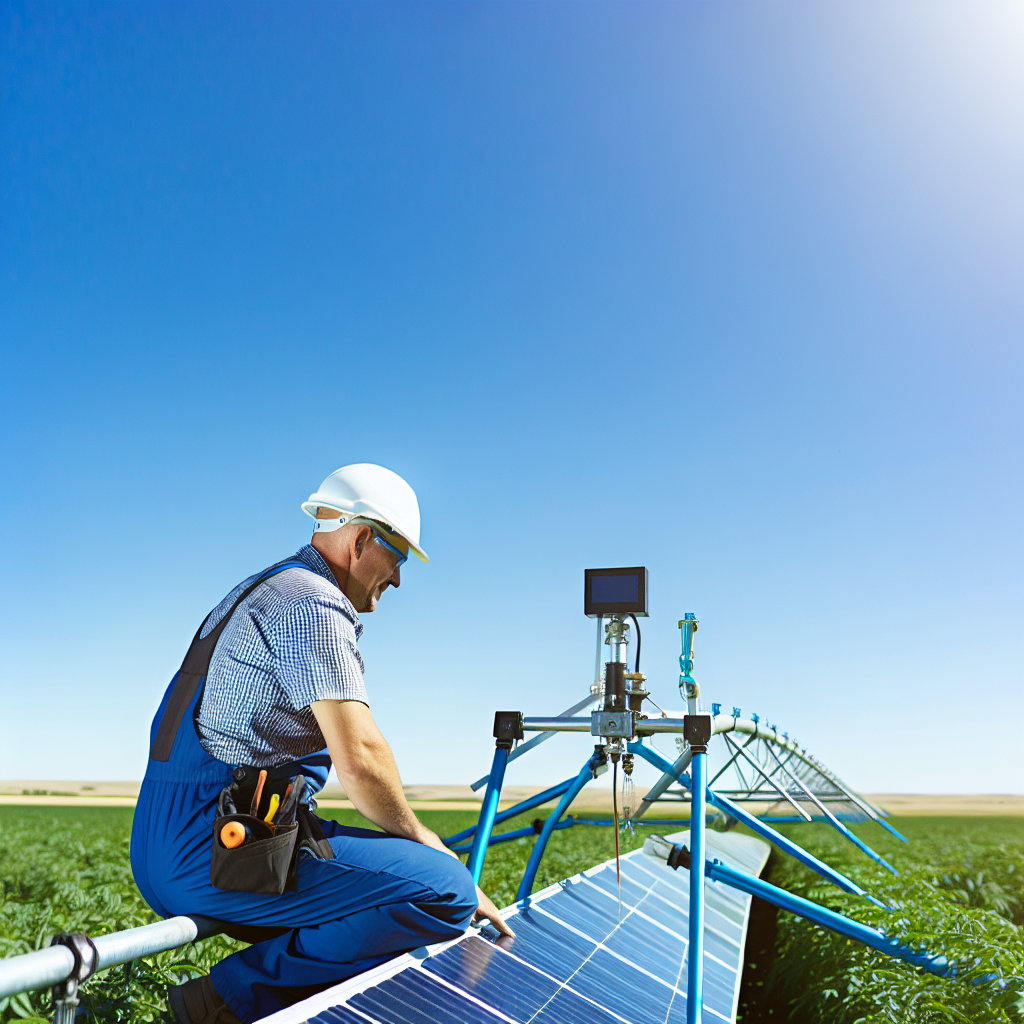
Economic Analysis: Cost-Benefit of Investing in Solar Irrigation Systems
Initial Investment Costs
Investing in solar-powered irrigation systems involves initial capital expenses.
These costs include the purchase of solar panels, pumps, and installation services.
However, these initial expenses often decrease over time due to technological advancements.
Operational Efficiency
Solar irrigation systems significantly reduce operational costs.
They use free solar energy, eliminating the need for fossil fuels.
This results in lower utility bills and improved profit margins for farmers.
Water Conservation Benefits
Efficient water use is critical in agriculture.
Solar-powered systems optimize water distribution through advanced technology.
This leads to reduced water waste and improved crop yields.
Farmers can manage their resources more effectively in drought-prone areas.
Government Incentives and Programs
Many governments offer financial incentives for solar irrigation investments.
Subsidies and grants can alleviate some initial costs for farmers.
These programs encourage sustainable farming practices and renewable energy use.
Long-Term Financial Benefits
Investing in solar irrigation provides long-term savings.
Reduced energy and water costs increase overall profitability.
Farmers benefit from increased land value and sustainable farming practices.
Evaluating the Economic Viability
The investment in solar irrigation systems is economically viable.
Benefits include cost savings, efficiency, and environmental stewardship.
Farmers can expect a favorable return on investment over time.
Discover More: Livestock Farming: Reducing Greenhouse Gas Output
Challenges and Solutions in Implementing Solar-Powered Irrigation
Understanding the Key Challenges
Implementing solar-powered irrigation faces several challenges.
Financial constraints often hinder many farmers from investing in these systems.
Additionally, initial installation costs can be high.
Limited technical skills among local populations also pose a significant barrier.
Moreover, variability in solar energy availability affects system efficiency.
Finally, the lack of infrastructure for maintenance complicates long-term use.
Cost-Effectiveness and Financing Solutions
Funding options can significantly alleviate financial burdens.
Government grants and subsidies encourage the adoption of solar technologies.
Additionally, microfinance opportunities help small farmers finance their systems.
Community co-operatives can pool resources for shared solar-powered irrigation systems.
Showcase Your Farming Business
Publish your professional farming services profile on our blog for a one-time fee of $200 and reach a dedicated audience of farmers and agribusiness owners.
Publish Your ProfileInvestments in training can ensure locals acquire necessary skills for maintenance.
Long-term savings from reduced energy costs justify initial expenditures.
Enhancing Technical Skills in the Community
Local educational programs can address the skills gap in communities.
Workshops can provide hands-on training for system installation and repair.
Furthermore, partnerships with local universities can enhance knowledge sharing.
Online resources also offer valuable training materials for farmers.
Collaboration with NGOs can expand outreach and training opportunities.
By investing in education, communities become more self-sufficient in managing systems.
Optimizing Solar Energy Utilization
Integrating energy storage solutions can mitigate variability issues.
Batteries and tanks allow for better energy management during low sunlight periods.
Advanced weather forecasting can improve irrigation scheduling.
Furthermore, adjustable systems can adapt to varying weather conditions.
Deploying smart irrigation technology enhances water use efficiency.
Regular assessments can help optimize system performance over time.
Ensuring Proper Maintenance and Support Structures
Establishing a local support structure is crucial for sustainability.
Regular maintenance checks can prolong the lifespan of irrigation systems.
Training local technicians creates a skilled workforce for ongoing support.
Additionally, forming local support groups can foster knowledge exchange.
Employing mobile maintenance units can provide timely assistance in emergencies.
Ultimately, a strong community network ensures effective system management.
Future Trends: Innovations in Solar Irrigation Technology and Water Management
Emergence of Smart Irrigation Systems
Smart irrigation systems utilize advanced technology for efficiency.
They integrate weather data to optimize water usage.
These systems reduce waste by adjusting to environmental conditions.
For instance, soil moisture sensors provide real-time data feedback.
This technology facilitates precise watering schedules.
Integration of IoT in Agriculture
The Internet of Things (IoT) enhances solar irrigation systems.
It enables devices to communicate seamlessly over the internet.
This connectivity allows for remote monitoring and control.
Farmers can adjust irrigation from their smartphones or tablets.
Consequently, they save time and improve water management.
Advancements in Solar Technology
Solar panel efficiency continues to improve rapidly.
Innovative designs harness more sunlight for energy production.
These advancements reduce operational costs for farmers.
Moreover, new battery technologies allow for energy storage.
This feature ensures constant water supply during low sunlight periods.
Development of Hybrid Systems
Hybrid systems combine solar power with traditional energy sources.
Such approaches provide reliable water management solutions.
This versatility helps farmers adapt to changing climates.
Furthermore, it enhances productivity across diverse farming operations.
Focus on Sustainable Practices
Current trends emphasize the importance of sustainability.
Showcase Your Farming Business
Publish your professional farming services profile on our blog for a one-time fee of $200 and reach a dedicated audience of farmers and agribusiness owners.
Publish Your ProfileFarmers adopt eco-friendly irrigation methods to conserve resources.
Solar-powered systems significantly reduce carbon footprints.
Additionally, implementing rainwater harvesting boosts water supply.
Such practices promote long-term agricultural resilience.
Additional Resources
NRCS Climate-Smart Mitigation Activities | Natural Resources …
Water scarcity in agriculture: An overview of causes, impacts and …

